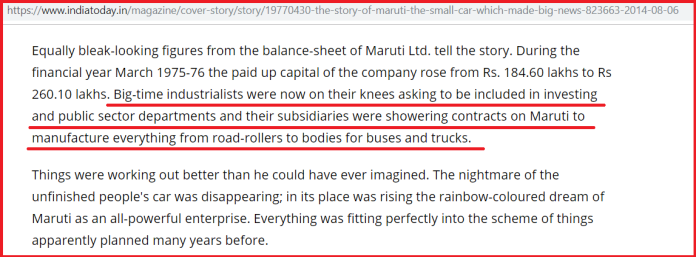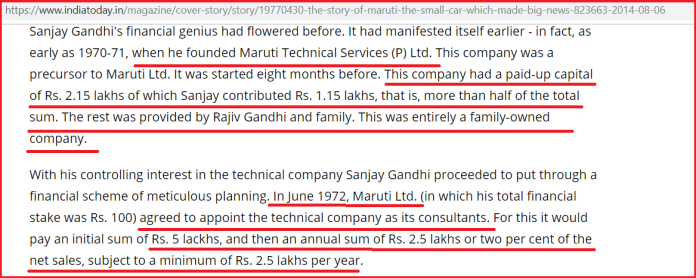Every kid growing up in India knows that the ‘Nehru-Gandhi’ name is associated to a lot of things. Buildings, roads, streets, parks, airports, everything…
If you want to spend anywhere between 10-15 years as a “college student”, you can always go to Jawaharlal Nehru University (JNU). If you are the type who prefers to learn on his own time, there is always Indira Gandhi National Open University (IGNOU). If you are not the bookish type and want to excel in sports, you can always dream of winning the Rajiv Gandhi Khel Ratna award someday!
But a lot of people don’t know just how deep the Nehru-Gandhi name runs in India. This is the story of an Indian brand name that we all know about Maruti … and the dark crony capitalist history behind it.
The story begins around 1970. The Indian Government and the Indian public were beginning to think about an indigenous car. It had to be a small car, suited to Indian conditions and something that the “upper middle class” could afford to pay. Which was not a lot, after 200 years of British and 20 years of Congress rule.
For India the breakthrough was to come with the arrival of a dynamic young inventor, whose project Prime Minister Indira Gandhi described in these glowing terms:
”a delicate young man, and with whatever money and energy he has, he has modelled a car, not a posh one, but one fairly comfortable and suitable to Indian conditions … has shown enterprise and I just could not say no to him … if he is not encouraged how can I ask other young men to take risks”
Which young man is she talking about? Her son Sanjay Gandhi of course. How could she say no to him?
Like so many great visionaries and inventors, Sanjay never went to college. But it was said that he loved cars and he had a mother who “could not say no to him.” Just like all those other visionaries we’ve heard about.
In 1970, Maruti received a license to produce 50,000 cars a year and the project began. Sanjay settled on a piece of land near Gurgaon for the factory, at which point two minor problems presented themselves. The first was that it was agricultural land. This was quickly solved. I am sure the farmers received a fair compensation for their land.
The second minor problem was that there was a military ammunition dump nearbly and there was a rule about not building anything within a kilometer of that. This problem was solved as well … by getting the military to move the ammunition dump.
Getting money for the project was no problem at all. Government contractors and traders were lining up to invest in the mission. In fact, traders came forward and paid Rs 3 lakh as deposit each to become future dealers as and when the car would be ready. Like Indira Gandhi, perhaps they too just could not say no to Sanjay.
So far, so good. But there was still the tiny matter of actually making a car that works.
After several years of waiting, Maruti built a prototype, which was sent for testing to the Vehicle Research & Development Establishment, Ahmednagar.
The prototype failed the test.
At this point, some of those people who had deposited money with Maruti wanted a refund. But there was a simple procedure to deal with such situations (see this India Today issue from 1977).

That’s right. The process of ‘Deposit Wapsi’ is much more complex than Award Wapsi.
Nevertheless, the criticism was beginning to pile up and reached a crescendo in mid-1975.
Did I say mid-1975? Yes, I did. On June 25, 1975, Prime Minister Indira Gandhi declared a state of Emergency.
Everyone who ever made a great invention has faced doubters. So did Sanjay. Just that he had a much more effective way of putting those doubts to rest.
We don’t talk much about the Emergency today. But even when we do, we speak of the Emergency as a purely political exercise. We rarely talk about the financial interests that might have been involved.

Here’s the key. Sanjay was only a director in Maruti, where his total financial stake was just one share he had purchased for Rs 100.
However, there was a second company called Maruti Technical Services (MTS) Pvt Limited. Let’s see who owned that:

So Maruti Limited decided to appoint Maruti Technical Services (owned by the family) as a “consultant”.
Maruti Technical Services (MTS) was to receive two percent of the net sales, subject to a *minimum* of Rs 2.5 lakh per year.
Notice that MTS had a paid up capital of just Rs 2.15 lakh and the company would be making a *minimum* of Rs 2.5 lakh per year. Good return on investment, you bet.
Sanjay Gandhi may have had a fascination for cars, but his real talent lay in financial matters.

Eventually, after the Janata govt came to power, the loss making Maruti Ltd. was liquidated. But this did not affect the profits that the Nehru-Gandhis earned through Maruti Technical Services.
The ‘Maruti’ that we know today was restarted in 1980 with help from Japan’s Suzuki.

Even so, the dark taint of cronyism will forever cling to the name of one of India’s best known companies.



